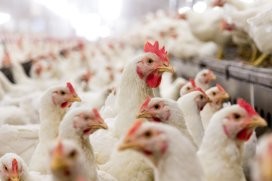Broiler breeders roost on perches, no adverse effects

Younger broiler breeders are more likely to use perches without impairing production, according to research published in the latest edition of Poultry Science.
The Swiss study looked at the effects of perch use by broiler breeders and its implication on health and production. It was carried out in the light of studies that shown perching to be a high priority behaviour in laying hens.
Researchers at the Centre for Proper Housing (Poultry) at the Department of Animal Welfare at the University of Bern studied whether broiler breeders used elevated perches of different lengths during the night and how access to perches affected health and production.
Using the Ross 308 hybrid, pens offering four different perch spaces per bird (5, 10, 14 and 20cm) in a cross-over design were compared with pens without perches. The number of birds on perches at midnight were recorded seven times during production.
Prevalence of keel bone fractures, breast blisters, pododermatitis and plumage quality of hens was assessed at 45 weeks and production was monitored on a daily basis.
To determine subsequent effects on offspring, chicks from hens with and without perches were reared and their growth rates assessed.
Analysis found more broiler breeders perches at night when 14cm perch length per bird was provided than with less available perch length, but there was no difference between 14 and 20cm per bird.
Perch use tended to decline with age from about 50% usage to 20%. Keel bone fractures were present in a quarter of hens and were not affected by presence of perches.
The growth of chicks was also unaffected by the parent treatment.
The paper’s abstract concluded that: “Our results suggest that perches were chosen for roosting by broiler breeders depending on their age and did not impair production.”













